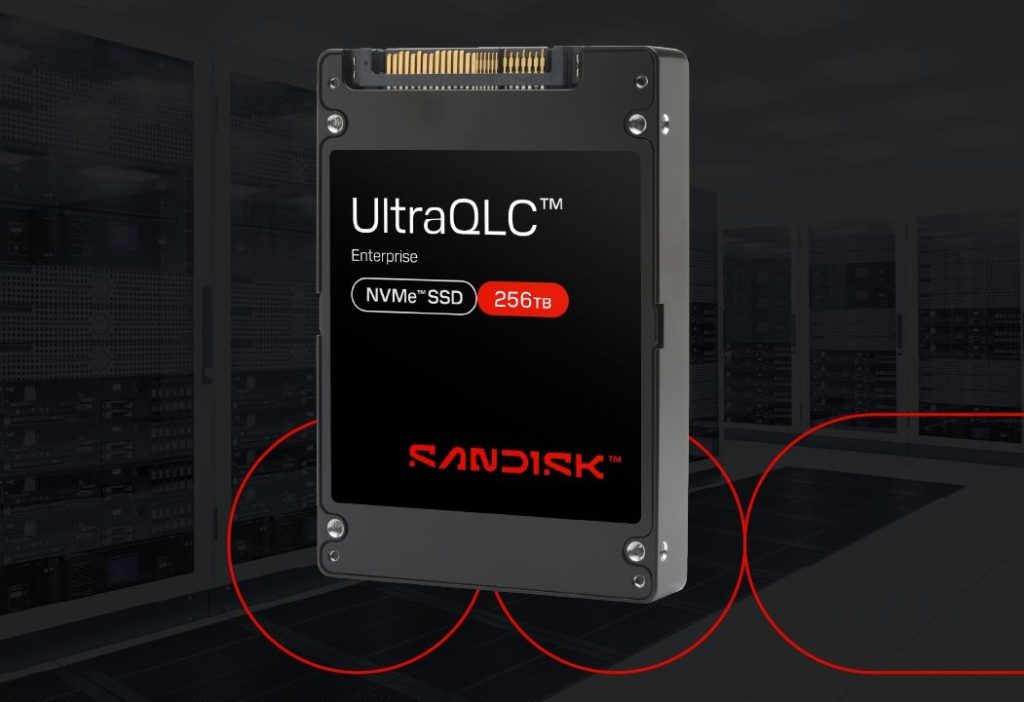SanDisk has once again pushed the limits of storage technology with the introduction of its groundbreaking 256TB NVMe SSD, built on the brand-new UltraQLC platform. Designed specifically for AI-centric and hyperscale cloud environments, this SSD offers an unprecedented blend of massive capacity, power efficiency, and robust performance to meet the demands of today’s data-intensive workloads.
UltraQLC Platform and Key Innovations

A Leap in Storage Density and Efficiency
SanDisk’s UltraQLC platform integrates advanced BiCS8 QLC NAND technology, leveraging a 2Tb BiCS8 QLC die that doubles storage density without increasing die size. This breakthrough allows the 256TB SSD to pack astonishing capacity into a compact U.2 form factor, setting a new industry benchmark for enterprise storage.
Direct Write QLC for Power-Loss Safety and Performance
One of the standout features is Direct Write QLC technology, which enables data to be written directly to QLC memory without relying on slower, power-hungry SLC caching. This approach improves write performance, reduces latency, and ensures power-loss-safe writes on the very first pass—critical for reliable AI and cloud applications.
Dynamic Frequency Scaling for Enhanced Power Efficiency
With dynamic frequency scaling, the SSD intelligently adjusts its controller frequency to optimize performance per watt, delivering up to 10% greater efficiency. This makes the drive ideal for energy-conscious hyperscale data centers where balancing speed and power consumption is paramount.
Reliability and Performance Enhancements
Extended Drive Lifespan with Data Retention Optimization
SanDisk has incorporated a sophisticated Data Retention profile that reduces the number of refresh cycles (DR recycles) by up to 33%. This translates into longer drive life, less maintenance overhead, and more consistent data access—essential qualities for enterprise-grade SSDs deployed in demanding environments.
Custom Multi-Core Controller and Firmware Tuning
The SSD features a scalable multi-core controller tailored for high throughput and enhanced endurance at such extreme storage densities. Alongside custom firmware optimizations, this configuration ensures smooth handling of AI data lakes, fast data ingestion, and real-time analytics.
Availability and Form Factors
SanDisk plans to launch the 256TB UltraQLC NVMe SSD in the popular U.2 form factor during the first half of 2026. This will be accompanied by the SN670 128TB variant, also built on the UltraQLC platform. Additional form factors are expected later in the year, broadening the range of deployment options for diverse enterprise needs.
Why SanDisk’s 256TB SSD Matters for AI and Cloud Workloads
As AI workloads grow exponentially, the need for ultra-high-capacity, power-efficient, and reliable storage solutions becomes critical. SanDisk’s 256TB UltraQLC SSD answers this industry call by enabling organizations to build larger, faster, and more cost-effective AI data lakes and hyperscale environments. Its cutting-edge architecture supports massive datasets, reduces total cost of ownership, and delivers consistent performance, positioning it as a future-proof storage solution for AI, cloud computing, and big data applications.
At a Glance: SanDisk 256TB UltraQLC NVMe SSD Features
| Feature | Specification |
|---|---|
| Capacity | 256TB |
| NAND Technology | BiCS8 2Tb QLC NAND |
| Platform | UltraQLC |
| Form Factor | U.2 (additional formats planned later) |
| Interface | PCIe Gen5 NVMe |
| Key Technologies | Direct Write QLC, Dynamic Frequency Scaling, Multi-core Controller |
| Power Efficiency | Up to 10% improved performance per watt |
| Reliability | Data Retention profile reducing refresh cycles by 33% |
| Target Use Cases | AI workloads, hyperscale cloud, data lakes, data ingestion |
SanDisk’s latest 256TB UltraQLC SSD is an industry-leading storage breakthrough, combining vast capacity with advanced power-saving and reliability features tailored for AI and cloud infrastructures. Expected to launch in the first half of 2026, it promises to redefine enterprise storage scalability and performance for years to come.




